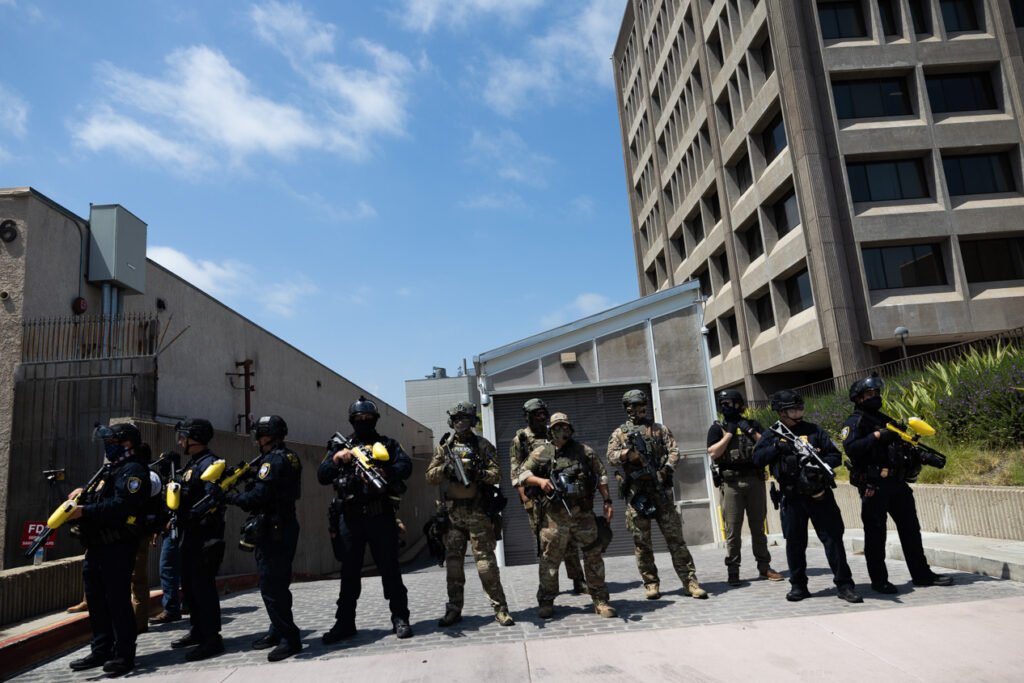As dawn breaks over Santa Ana, public buses stop, and day laborers gather, exchanging whispers and worried glances. In recent weeks, the air has thickened with fear, each passing vehicle igniting dread among the community, as federal immigration agents appear to be lurking closer than ever.
Questions Continue Mounting Over ICE Raids in Orange County
Positive reports of the economy’s recovery stand in stark contrast to the palpable anxiety reverberating through immigrant populations in Orange County. Critics argue that the latest wave of immigration raids, prioritized over transparent enforcement policies, has led to the unjust targeting of individuals without criminal records. Community leaders and local congressional representatives are demanding clarity on who exactly is being pursued by Immigration and Customs Enforcement (ICE) amid allegations of indiscriminate raids.
Federal Officials Under Scrutiny
Questions surrounding the federal government’s immigration enforcement tactics have intensified, with several members of Congress, including Congressman Lou Correa (D-Santa Ana), expressing significant concerns. “This administration refuses to provide accurate data regarding who is being arrested and why,” he declared in a recent letter addressed to Homeland Security Secretary Kristi Noem. Correa argues that since the Trump administration, data transparency around ICE operations has dwindled dramatically, obscuring the reality of these law enforcement actions.
“Without proper oversight and accountability, we are left to wonder just how widespread these arrests truly are,” Correa added, voicing fears that the administration is perpetuating a cycle of fear among law-abiding residents.
Organized Resistance and Legal Actions
In response to rising concerns, a federal lawsuit has emerged, spearheaded by California Attorney General Rob Bonta and supported by the American Civil Liberties Union (ACLU). The lawsuit aims to end what critics describe as unlawful enforcement practices, seeking to halt warrantless stops by federal agents without clear, individualized suspicion. “These raids are not about safety or justice. They are about meeting enforcement quotas,” Bonta stated emphatically.
Public Fear Versus Community Safety
New data reveals a disconcerting trend: nearly 84% of individuals detained over a recent two-month period in California are classified as “no ICE threat,” according to the Department of Homeland Security. Advocates are concerned that the increased pressure to meet arrest quotas—3,000 individuals a day—forces ICE to apprehend vulnerable individuals instead of genuine threats to community safety.
- Widespread uncertainty across affected communities.
- Reports of individuals being arrested after required check-ins.
- Calls from Congress for transparent data on ICE enforcement.
The Community’s Response
As cities like Los Angeles join the lawsuit, those in Orange County have begun to rally. City council members from Santa Ana, Orange County’s only sanctuary city, assert that they must stand united against what they perceive as federal overreach. Councilman Johnathan Hernandez highlighted this urgency, stating, “These raids are a violation of our community’s rights and necessitate immediate legal action.”
Public sentiment also reverberated in the streets. During a recent protest, a diverse group of residents marched, asserting their right to safety and due process. “Our families are being torn apart, and our children live in fear. This cannot go on,” reflected one protester, resonating with many as they demand accountability from federal agents.
Local Economy at Stake
Interestingly, the current immigration wave has not only mobilized immigrant advocates but has now drawn the attention of local business leaders and even some Republican legislators. A group of Assembly members, including Republicans like Laurie Davies and Diane Dixon, expressed concerns that such a crackdown is driving skilled workers away from critical industries, exacerbating California’s affordability crisis.
“We support the enforcement of federal law, but the current methods jeopardize the local economy and public safety,” the bipartisan group stated in a letter directed at President Trump. “These actions induce a chilling effect among workers. We urge you to recalibrate ICE’s focus toward genuine criminal threats.”
Community Voices on the Ground
In tandem with rising political actions, community organizations like the Orange County Rapid Response Network are mobilizing resources to assist families affected by ICE raids. Leaders stress the importance of remaining vigilant yet supportive. “It’s about providing necessary services and ensuring our neighbors know their rights,” said a local activist. “Families need to be aware of the resources available to them during these turbulent times.”
For many immigrants, the fear of deportation has overshadowed daily life altogether. Some have opted to adjust their routines, avoiding public spaces where ICE is known to operate, including jobsites and transit hubs. Economic repercussions persisted: local markets report sharp declines in clientele, attributing the trend to the pervasive fear of raids affecting families’ willingness to venture out.
The Ongoing Debate
The political and social ramifications of the current immigration enforcement tactics are vast and nuanced, sparking discussions about the essence of community safety, civil liberties, and public policy. As the wave of enforcement operations continues to disrupt lives, advocates are urging local governments to join forces, demanding a better approach to immigration issues.
As the situation evolves, Congress and state legislators, alongside community advocates, must grapple with the pressing question: Are these tactics truly about enforcing the law, or are they creating a toxic environment that undermines the very fabric of our freedoms and the stability of our communities? As this story continues to unfold, the rights and dignity of countless individuals are at stake, calling for action and dialogue in every corner of America.





